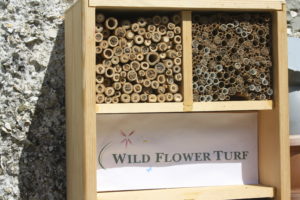
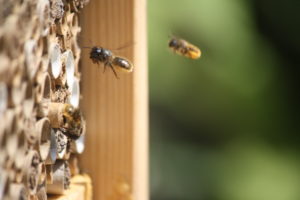
Earlier in the year, we were invited to get involved with a mason bee project as an offshoot of Operation Pollinator. We knew that these amazing insects were incredibly important for our wildflower turf pollination but as we started to find out more about them we felt compelled to share all that we have learnt about the busiest of bees and encourage you to get involved. Without insect pollination, there will be a serious decline in the production of the fruit and vegetables we eat. As well as crops, most wild plants also require insect pollination.
Bees and other pollinators are known to be in decline and whilst no single factor is to blame the loss of habitat is key to their survival. Our mason bee hotel project is certainly going to help our wildflower turf flourish.
FIVE FASCINATING FACTS ABOUT THE MASON BEE
1. Mason bees live solitary lives. All females are able to lay eggs. Once the male bees have mated they then die. Mason bees do not create honey or wax and consequently are very docile. They are only likely to sting if pinched or stamped upon.
2. 70% of our UK flowers are pollinated by mason bees and bumble bees. They carry pollen and nectar dry, and so are far more effective than the honey bee, who carries nectar and pollen by wetting their legs. They travel within a 60-90m circle around their nesting hole and it is said that one mason bee will pollinate the equivalent number of flowers that up to 100 honey bees would achieve, which is potentially 4000 flowers a day.
3. Mason bees can fly at much lower temperatures than honey and bumblebees. Therefore they start to pollinate earlier on in the Spring. They particularly like the pollen of fruit trees but are actually less fussy than the honey bee and will forage amongst all of the spring flowers. They are known to be the very best pollinators of fruit trees.
4. The female bees make nests in natural matter , often a hollow stem, such as a reed but they also can work their way into holes in stone or brickwork. They make a bed of sludge or mud and then fill it with pollen and nectar as a food store for the larvae. The female reverses into the hole and lays an egg. She then creates the next compartment by adding another layer of mud and the process starts again. She may lay up to several dozen eggs.
5. The eggs are laid and hatch as larvae which eat the nectar and pollen store left for it. The bee very cleverly lays the females first, the male eggs being laid to the front of the nest. This is believed to be for a number of reasons. The males are more superfluous than the females and therefore actually act as a protective barrier to the females should birds find the nest and peck out a tasty snack. Secondly they hatch first in order to prepare themselves for the females who fly a little later, having developed at the back of the nest. Research has shown how each bee in the tube has a staggered development time so the first egg laid actually takes the longest to develop into a bee, so that all the other bees in the line have flown, giving an easy passage out of the nest.
BEE HOTEL
The Red Beehive Company who have been advising Syngenta, the originators of the urban pollinators project, very kindly gave us a sample bee hotel last year and we are pleased to say that by the same time this year there were very few vacancies left within the cavities. It is a wooden construction with a series of compartments filled with small cardboard tubes, perfect for nesting mason bees. The bees were very active throughout May and we have some video footage to show you them in action.
http://www.youtube.com/watch?v=yLUgk7SIcDY
The bee hotel was placed just outside our office on a warm south facing wall. Interestingly, whilst solitary, a good nesting place attracts many bees.

We thought it would be a useful exercise to show you just how the bees make their nest. We assure you that no bees were hurt during this process and are now tucked back safely into their cosy hotel, hopefully to hatch in early spring next year.
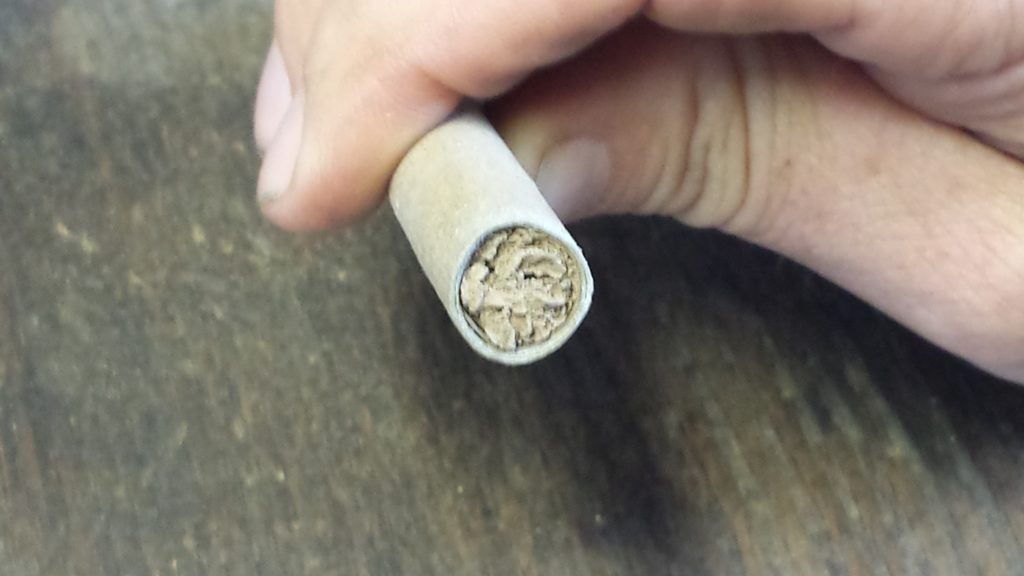
Here you can see a cardboard tube that has been used to create a nest, a mud bed at the end of the tube indicates that it is full of larvae.
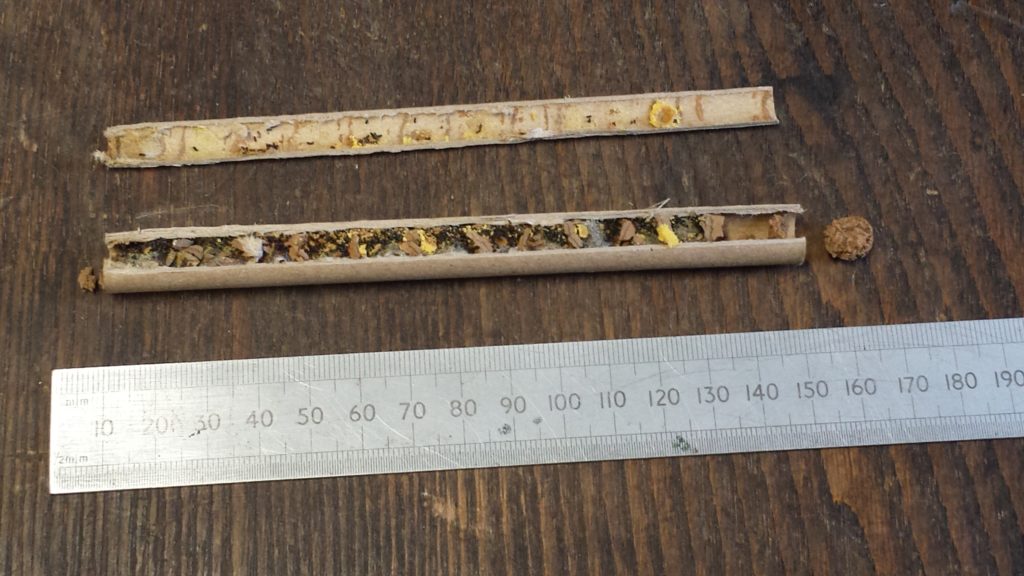
We carefully sliced the tube to see how the mason bee had made compartments of mud, nectar and pollen stores with a larva embedded in each compartment.
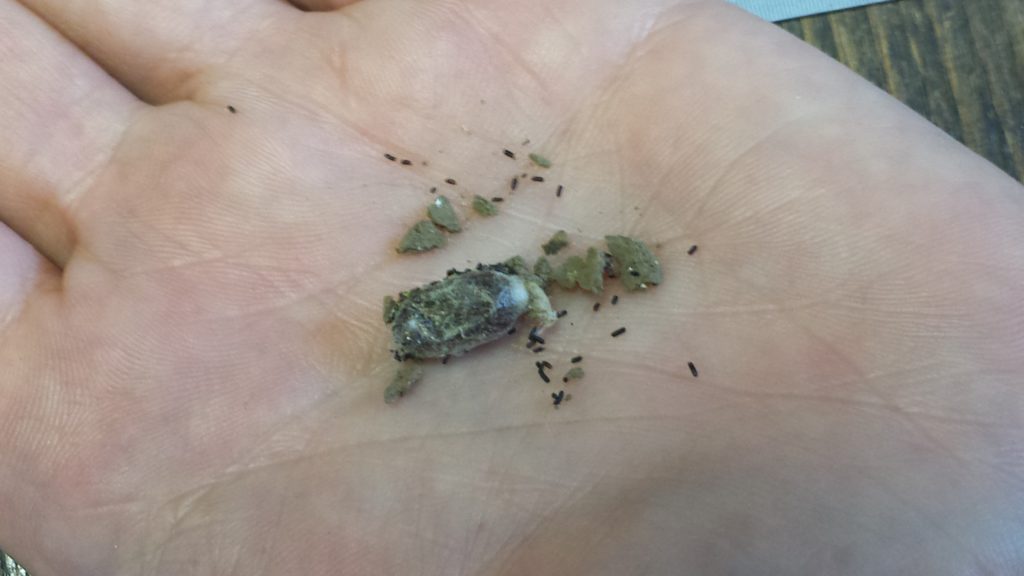
This is a bee larva, the little black dots are pollen.
We counted 10 larvae in this one tube – the potential of 400,000 flowers to be pollenated in such a ridiculously small home is quite incredible.
With the obvious benefits to our turf, arable fields and fruit trees on the farm, we hope to put up a number of other bee hotels. We will be selling these bee hotels in the near future, we think they make a perfect present to any nature lover, wildflower grower, fruit tree obsessive or anyone that wants to do their bit for this fantastic insect. Please contact us if you would be interested in purchasing a hotel.


